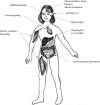Nuclear genes involved in mitochondrial diseases caused by instability of mitochondrial DNA
- PMID: 29344903
- PMCID: PMC5799321
- DOI: 10.1007/s13353-017-0424-3
Nuclear genes involved in mitochondrial diseases caused by instability of mitochondrial DNA
Abstract
Mitochondrial diseases are defined by a respiratory chain dysfunction and in most of the cases manifest as multisystem disorders with predominant expression in muscles and nerves and may be caused by mutations in mitochondrial (mtDNA) or nuclear (nDNA) genomes. Most of the proteins involved in respiratory chain function are nuclear encoded, although 13 subunits of respiratory chain complexes (together with 2 rRNAs and 22 tRNAs necessary for their translation) encoded by mtDNA are essential for cell function. nDNA encodes not only respiratory chain subunits but also all the proteins responsible for mtDNA maintenance, especially those involved in replication, as well as other proteins necessary for the transcription and copy number control of this multicopy genome. Mutations in these genes can cause secondary instability of the mitochondrial genome in the form of depletion (decreased number of mtDNA molecules in the cell), vast multiple deletions or accumulation of point mutations which in turn leads to mitochondrial diseases inherited in a Mendelian fashion. The list of genes involved in mitochondrial DNA maintenance is long, and still incomplete.
Keywords: Depletion; Mitochondrial DNA deletions; Mitochondrial DNA instability; Mitochondrial diseases; Nuclear genes.
Conflict of interest statement
Ethical approval
This article does not contain any studies with human participants performed by any of the authors.
Conflict of interest
The authors declare that they have no conflict of interest.
Figures
References
-
- Antonenkov VD, Isomursu A, Mennerich D, Vapola MH, Weiher H, Kietzmann T, Hiltunen JK. The human mitochondrial DNA depletion syndrome gene MPV17 encodes a non-selective channel that modulates membrane potential. J Biol Chem. 2015;290(22):13840–13861. doi: 10.1074/jbc.M114.608083. - DOI - PMC - PubMed
Publication types
MeSH terms
Substances
Grants and funding
LinkOut - more resources
Full Text Sources
Other Literature Sources
Medical



